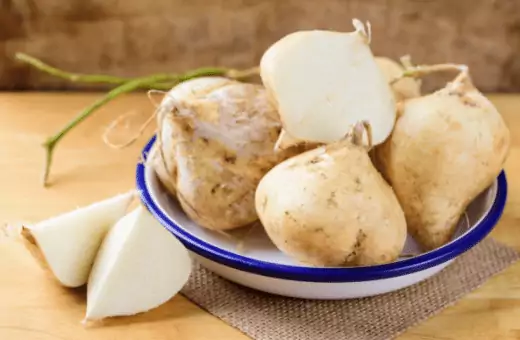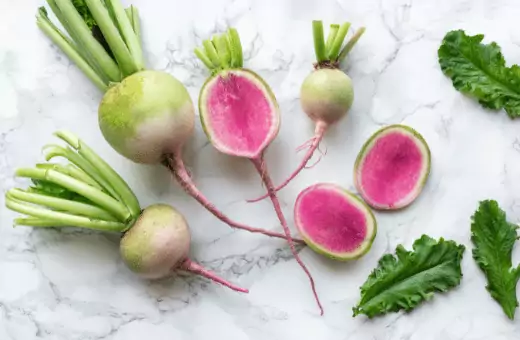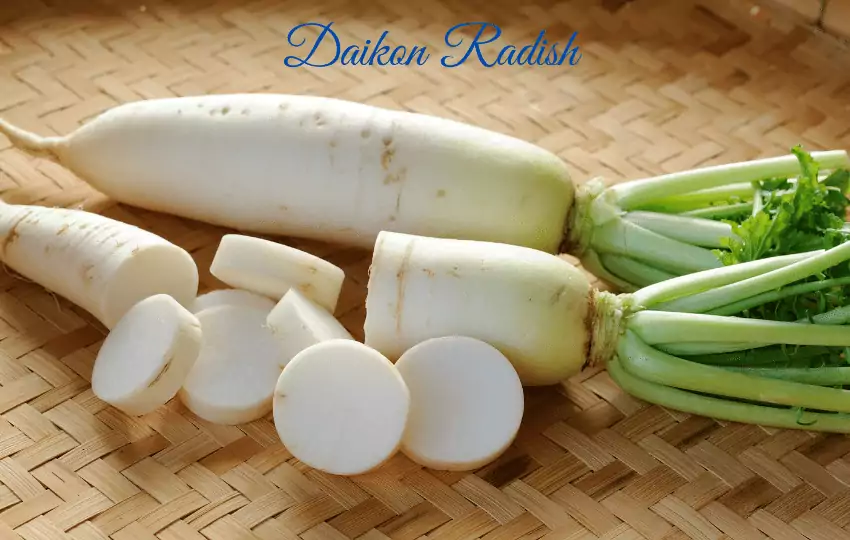Daikon is a large, white radish that grows in the ground. It has an excellent crunchy texture and can be eaten raw or cooked with other vegetables.
Daikon’s flavor is slightly sweet, and it’s often used to make pickles. If you’re looking for a substitute for daikon, try regular radish!
It’s not always easy to find daikon radish, but there are substitutes you can use, like turnips or horseradish root.
I’ll go over what they each taste like and how to make them into an alternative to Daikon in various things.
What does daikon taste like? Should daikon be peeled?
Some people might say that daikon radish has a bitter taste, but I believe its unique flavor is something special.
Daikon radish is definitely one of my favorite vegetables because of its refreshing crunch, slightly tangy flavor, and light sweet aftertaste.
I enjoy eating it raw in salads or simply diced up and added to my meals.
Should you peel daikon before eating? I guess this answer is you may or may not.
Daikon takes either cook or raw. And the skin is slightly bitter to avoid bitterness or dirt you can eat without the peel. Otherwise, no problem with the daikon skin.
What can I substitute for daikon radish? (Daikon alternatives)
1. RADISH
Radishes are root vegetables, typically red or white in color. They have a peppery flavor and are eaten raw or cooked. That’s why it’s perfect for the daikon radish substitute.
The crunchy and juicy at the same time red or white good to go with any daikon recipe like Kimchi, stir-fry, soup, etc.
2. JICAMA
Jicama is not only delicious, but it is also suitable for you. This crunchy tuber can be eaten raw, cooked, or even juiced.

The Jicama is also popular as a yam bean, and it’s not actually a bean at all – it’s more closely related to the potato.
Jicama is an excellent alternative to daikon in mixed root vegetable salads. It has a sweet and crunchy taste that pairs well with the other vegetables, and the thin skin means you don’t have to peel it.
This recipe is easy to cook and ideal for a nutritious and tasty side dish or snack:
1. Start by cutting the jicama into thin matchsticks using a sharp knife. It will be better if you have a mandoline slicer!
2. In a large bowl, mix the jicama with some shredded carrots, daikon, and red cabbage.
3. In a smallish bowl, mix the dressing ingredients: 1/4 cup rice vinegar, 2 tablespoons honey, 1 tablespoon sesame oil, and 1 teaspoon soy sauce.
4. Pour the dressing over the vegetables and toss until everything is evenly coated.
5. Serve cold or at room temperature. Enjoy!
Read More- Substitution for artichoke
3. TURNIP
Turnips are root vegetables that look like white and purple radishes. They’re related to cabbage and broccoli, but they taste like neither of them.
Instead, turnips have a slightly bitter taste that many people describe as “spicy” or even “hot.”
Some people say that the flavor of turnip is similar to horseradish, which is a relative of mustard. Try using turnips instead if you can’t find daikon or look for a different taste.
It’s perfect for dishes like this one-
1. Peel and chop the turnip into small pieces.
2. In a pot on medium heat, simmer water and season with salt.
3. Add the turnips and cook until tender.
4. Drain the water and serve with your choice of sauce.
4. KOREAN RADISH
Korean Radish or you can say “Mu,” is a type of winter radish grown throughout Korea. Mu is generally harvested in the late fall and early winter. Still, you can currently find it at some farmer’s markets year-round.
It is sometimes incorrectly referred to as daikon radish. Mu is a white, cylindrical radish that can grow up to 18 inches in length and 2 inches in diameter.
Korean Radish has a slightly sweet, peppery taste, a crispy texture, and another excellent daikon radish substitute. Mu is used in many dishes throughout Korea, both raw and cooked.
Soup: Replace daikon with Korean radish in any soup recipe. The Korean radish’s slightly sweet and spicy flavor will add a new dimension to your soup.
Salad: Replace daikon with Korean radish in any salad recipe. The crispy texture of the Korean radish will add a nice crunch to your salad.
Stir-fry: Replace daikon with Korean radish in any stir-fry recipe. The ability to keep its shape after cooking will give your stir-fry a nice crunch.
Read More- Best Korean Radish Replacement ( from kimchi to kimbap)
5. WATERMELON RADISH
Watermelon radish is another suitable replacement for Daikon radish. It is mainly found in China.

The watermelon radish’s crisp white flesh mixed with the deep red of the skin is a beautiful combination. The radish has a mild, sweet taste with a peppery finish.
Watermelon radish is a mild and refreshing root vegetable that can be enjoyed raw or cooked. You can enjoy it as a salad, slaws, soups, and stir-fries.
6. PONYTAIL RADISH
Ponytail radish, a.k.a Chonggakmu or Chonggak Radish. Ponytail radish is a type of vegetable that is related to the turnip. Found in many different colors, including white, red, and purple.
The radish stem is typically edible, but it should be removed before cooking because it becomes rigid once cooked.
Depending on the recipe, you can eat it raw or cooked depending on the recipe, and many people like to use them in salads because of their light flavor, soup, stir fry, and even pickle.
7. GEGEOL RADISH
Gegeol Radish or Gegeolmu is a Korean radish that is a popular winter vegetable in Korea. The vegetable has a long white cylindrical shape and is about a large carrot.
Gegeol Daikon has a slightly sweet and peppery taste and is often eaten raw in salads or side dishes.
8. SAKURAJIMA RADISH
While Sakurajima radish is a type of turnip, it has a distinctly different flavor and texture than the more common white or red turnips.
The coloring of this vegetable can also vary, with some specimens exhibiting a deep purple hue. The taste is peppery and slightly sweet, making it a popular addition to salads and other fresh dishes. It can be eaten raw or boiled, stir-fried, and pickled.
9. TAKUAN
Takuan a.k.a Takuan-zuke or Danmuji Takuan radish is a type of daikon radish that is typically eaten in Japan. It is a long, white radish with a slightly sweet and peppery taste. Takuan is often served as a side dish or in sushi rolls instead of Daikon Radish.
10. HORSERADISH ROOT
The horseradish root is a perennial plant member of the Brassicaceae family. The plant is native to Europe and Western Asia, but it is now widely grown worldwide.
The horseradish root is a thick, white, tapered root that grows 2 feet long. The root has a pungent, peppery taste.
Use Horseradish replace to daikon to give you a fantastic recipe for this tremendous and spicy food.
11. BEETROOT
Although Beetroot tastes slightly different from daikon, you can use beetroot in any recipe. The sweet, crunchy texture can be similar to daikon radish.
If you cannot find daikon or want to try something different, go ahead and use beetroots.
Ingredients: (Serves 2)
- – 2 servings of marinated cod roe
- – 1 medium-size beetroot or 2 young, small ones (1.5-2cm in diameter)
- – 3 Tbsp sugar
- – 5 Tbsp sake
- – 3 Tbsp rice vinegar (or regular vinegar)
- – 6 tbsp shoyu (soy sauce)
Preparation:
– Peel the skin of beetroots and cut them into 1cm cubes. The size does not matter, but they should be roughly about the same so that it is easier to cook them evenly.
– Put the cubes in a small pot and add sake, shoyu, and sugar. Mix well so that all pieces are lightly coated.
– Cook over medium heat until all the liquid has evaporated. This will take about 10 minutes. Stir occasionally to prevent sticking.
– Add rice vinegar and continue cooking for another 5 minutes or so, until the beetroots are slightly softened but still have a crunchy texture.
– Remove from heat and let cool.
– Serve the karashi mentai with the marinated cod roe.
The taste of this dish is slightly sweet and sour, with a little bit of heat from the karashi (Japanese mustard).
The beetroots add a nice earthy flavor and a slight sweetness to the mix. This can be eaten as an appetizer or as a side dish.
12. WATER CHESTNUT
Water chestnut is also known as Chinese water chestnut, sweet nut, bat nut, bubble fruit, elephant ear nut. It tastes like chestnuts with a crispy texture and juicy taste. Also, it has a little darker brown color than the regular white one.
Water chestnut has a nutty and sweet taste, similar to other chestnuts. However, it also has a slightly salty taste that sets it apart from other nuts.
Some people also say that water chestnut has a slightly metallic taste. This unique flavor makes water chestnut a great addition to many dishes.
You can use water chestnut instead of Daikon radish in eaten raw or cooked into stir-fries, desserts, or as a snack.
13. CABBAGE HEART
The cabbage heart is nothing but the core part of the cabbage. It is mainly removed while cooking. But you can easily use these parts as an alternative to daikon.
Use cabbage heart in your pickle, stir-fry, and so on.
Know More Substitutes- Know Napa Cabbage alternatives & Never miss your favorite recipe
My All-time Favourite Daikon Radish Alternatives
· Korean radish
· Radish
· Cabbage heart
· Turnip
· Water chestnut
· Takuan and so on.
Daikon Radish Substitute Kimchi
Not all radish go well in kimchi; some substitutes taste delicious in kimchi. Include
· Cabbage Heart
· Korean radish
· Red radish
· Watermelon radish
Are daikon radishes good for you?
The answer is yes! Daikon radishes are a great source of nutrients, including fiber, potassium, vitamin C, and folate.
They also contain antioxidants, which can help protect your body against disease.
Providing essential nutrients like calcium, iron, magnesium, and phosphorus.
What to do with leftover daikon radish? (16 Ways)
There are plenty of items you can do with leftover daikon radish. Here are a few ideas:
1. Use it to make veggie juice.
2. Add it to a salad or stir-fry.
3. Use it in place of cabbage in coleslaw.
4. Make a daikon radish slaw.
5. Use it to make pickles.
6. Fry it up and eat it as a side dish.
7. Puree it and add it to soup or stew
8. Roast it and serve with a dipping sauce.
9. Grate it and use it in place of cucumber in tzatziki.
10. Substitute it for ginger in stir-fries.
11. Add it to a steak marinade or sauce.
12. Make pickled daikon radish cubes with soy sauce, vinegar, sugar, water, and dry mustard.
13. Pickle it with simple vinegar, sugar, and salt mixture.
14. Sauté it with garlic and oil for a quick side dish.
15. Use it to make roasted daikon radish fries.
16. Add it to your next batch of Kimchi.
How long does daikon last in the fridge?
Typically, daikon can last in the fridge for about two to four weeks. However, if stored properly, daikon can last up to six months.
Make sure to keep the daikon in a cool, dry place and avoid contact with moisture.
If the daikon does start to spoil, it will have a slimy texture. If this happens, throw away the daikon immediately.
FAQs Daikon Radish & Its Alternatives
Q1. Daikon vs Radish
The most obvious difference between daikon and radish is the color.
The daikon is a white or cream-colored root that can reach a length of fifteen inches or more.
The radish is red or purple. Since it is usually smaller than the daikon at only around three to four inches in length, radishes are also known as salad turnips.
Another difference between the two vegetables is the flavor. Daikon has a very mild but slightly sweet taste. It can be used in all types of dishes and does not overwhelm other flavors.
The radish tastes much more spicy or peppery, making it an excellent addition to Asian dishes looking for some extra heat.
Radishes can be eaten raw or cooked. Daikon is usually eaten cooked, although it can also be eaten raw if grated very finely.
Daikon can be boiled, steamed, or stir-fried.
Q2. Is Mooli the Same as Daikon?
The answer is no. While they may look similar, the two vegetables are actually quite different.
Mooli, also known as white radish, is a mild-tasting vegetable often used in salads or as a side dish.
On the other hand, Daikon is a more pungent vegetable that is often used in soups or as a main course.
Q3. What is some Pickled daikon radish substitute?
Pickled daikon radish is a popular condiment in Asia, but it can be challenging to find in the United States.
If you are looking for a Pickled daikon radish substitute, try using pickled ginger or pickled vegetables.
Both options will give your dish a similar flavor profile. You could also use a simple vinaigrette or soy sauce and rice vinegar mixture as a Pickled daikon radish substitute.
Whichever option you choose, be sure to adjust the amount of salt and sugar in the recipe to taste.
Q4. Is daikon the same as parsnip?
No, daikon and parsnips are not the same. Daikon is a white, elongated radish that is typically grown in East Asia.
Parsnips are a pale brown root vegetable with a sweeter flavor than most other vegetables. They are most often grown throughout Europe.
Q5. Difference between Korean radish and Indian radish
There is a significant difference between Korean radish and Indian radish in terms of their shapes, sizes, and colors.
The Korean radish is typically long and cylindrical, whereas the Indian radish is more round and has red skin.
Indian radishes are also much smaller than Korean radishes.
Indian radish and Korean radish have similar tastes and flavors. They can both be used for making kimchi or boiled in soups.

